
FORD Mondeo Hatchback
Generations Timeline, Specs and Pictures
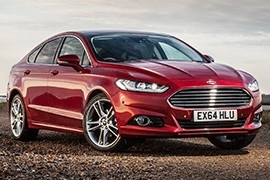
Ford showed the Mondeo in 2012 but left its European customers waiting until 2014 when the car finally arrived in showrooms.
Facing stiff competition against the Passat, Ford’s midsize vehicle had only one edge against its main competitor: the hatchback shape. Volkswagen offered its midsize contender only in sedan and station-wagon shapes.
The Mondeo showed an aggressive front fascia with a chromed slatted grille and narrow headlights, available with an adaptive LED system. Its bumper sported a lower grille with a reversed trapezoidal shape flanked by two scoops for the fog lights. In hatchback shape, the Mondeo looked more like a fastback, with a sloped and extended liftgate.
Inside, the carmaker’s designers burned the midnight oil to install the best interior ever made in a Mondeo. On the center stack, they placed the infotainment unit with the SYNC 2 connectivity system. The bolstered seats promised good side support during high-speed cornering. The Mondeo was no longer just another midsize sedan on the market; it was a sport-sedan and showed it. In the back, the split-folding bench allowed a trunk increase from 525 liters (18.5 cu-ft) up to 1,630 liters (57.6 cu-ft).
Under the hood, Ford installed the most comprehensive engine range ever for the Mondeo. It started with a 1.0-liter Ecoboost engine for selected markets and went all the way up to a 2.0-liter turbocharged unit which offered 240 hp.
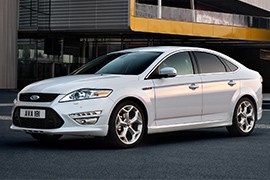
Ford launched the fourth generation of the Mondeo in 2006 and, four years later, it introduced the facelifted version for it.
Like its predecessors, the Mondeo was available with three body shapes: a three-box sedan, hatchback, and station wagon. Ford considered that this must be the best recipe for its mid-size European vehicle, and it didn’t need to increase or decrease these versions. After a successful launch in 2006, the fourth generation of the Mondeo went through a mid-life cycle refresh in 2010.
Ford followed the kinetic design update trend on the Mondeo, with a revamp of the front fascia, which included a wider lower grille and side-scoops. Its hood received further modifications due to the slimmer upper grille. A set of LED daytime running lights enhanced the vehicle’s front view, giving it a sporty premium look. From the sides, the chromed rims around the window lines emphasized the big glass area. In the rear, the Mondeo featured LED taillights. Depending on the trim level, the Mondeo hatchback featured a small lid-spoiler. This body version was the shortest among its siblings.
Inside, the facelifted mid-size sedan featured new materials and LED lighting. The material’s quality was improved. But the most significant upgrades were for the infotainment and safety features. Its new Sony sound system offered a dynamic sound processor and up to 10 speakers, and a 17-liter subwoofer in the trunk.
Another important upgrade was under the hood, where Ford offered a choice of diesel and gasoline engines. Power ranged between a 116 hp diesel unit and a 240 hp 2.0-liter turbocharged gasoline.
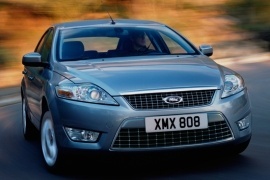
Ford showed the third generation of the Mondeo in the 2006 movie Casino Royale, but the official unveiling was made in 2007.
The Mondeo was built on the same platform as the Mazda 6/Atenza, and it was not sold in the U.S., like the first generation where the Fusion model filled that segment. The vehicle was available as a four-door sedan, five-door hatchback, and a station-wagon. The hatchback was the first to be unveiled.
Featuring a new design language, named kinetic-design, the Mondeo represented Ford’s biggest car on the European market. Its front grille left the rounded sides of the trapezoidal shape from its predecessor and adopted sharper, straight lines. On the other hand, the headlights were swept on the sides, with a bigger interior side. A wider lower grille was installed on the apron. From its sides, the hatchback featured a longer greenhouse and sloped rear end, and short decklid.
Inside, the Mondeo offered a roomy interior due to its long, 2.85 m (112.2 in) wheelbase. The dashboard was fitted with two analog dials and a central TFT screen. For the infotainment system, Ford installed a new infotainment system.
Under the hood, Ford installed a wide choice of gasoline or diesel engines. They ranged from a mere 1.6-liter 115 hp turbodiesel up to a 2.0-liter turbocharged gasoline unit that offered 240 hp. Most versions were mated to a 6-speed manual, while a 6-speed automatic was on the options list.

Ford continued to offer the Mondeo in three shapes: sedan, hatchback, and station-wagon, to directly compete against the French vehicles and the Opel/Vauxhall Vectra.
The second generation of the Mondeo was a pure example of the New Edge design done right. Over time, Ford decided to apply two mil facelifts for its European mid-size range.
The Mondeo’s second generation was a hit with its triangular headlights swept over the hood and the slim curved trapezoidal grille. It was introduced to the market in 2000, but its design was not outdated. Still, Ford decided to do a facelift on it and slightly changed the front bumper and the headlights.
Inside, the Mondeo hatchback was good looking with its dashboard that offered the same two big dials for the tachometer and speedometer and two small LCD displays on the bottom of them. A nice touch of luxury feel was the oval clock on the center stack, above the optional infotainment system, which featured a CD and sat-nav. Since the Mondeo was well known for its speed cornering abilities, the carmaker decided to install higher bolstering on the front seats, to keep the occupants in place. In the back, the split-folding seatback allowed the trunk to expand from a decent 541 liters (19.1 cu-ft) to 1437 liters (50.7 cu-ft).
The 2005 model received a new engine lineup, including the Duratorq diesel engines offered in four different power outputs.
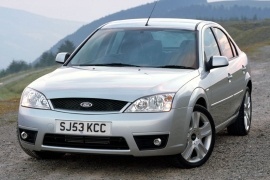
After just two years since its introduction, the Mondeo’s second generation received a mild facelift, which slightly improved its look and some interior trims.
The Mondeo was on top of its class and, in some countries, it was leading the mid-size segment thanks to its broader choice of bodyworks than its main rival, the Volkswagen Passat. The blue-oval lineup was available as a sedan, a hatchback and a station wagon. Only the Opel/Vauxhall Vectra was offered with the same choice of bodies.
From the outside, the only noticeable change was for the grille, which featured a chrome surrounding and a honeycomb mesh grille. The bumper was enhanced as well, with the introduction of larger fog-lights in different casings. On the sides, the turn-signals that were mounted on the fenders were transparent instead of orange. In the back, the taillights featured transparent lenses for the turn-signals on the 2003 model-year instead of red, but the carmaker couldn’t solve the issue with the wide C-pillar on the hatchback version.
Inside, Ford enhanced or changed some parts to improve the car’s quality. For instance, it signed a deal with Sony to provide the CD-radio unit, which was much better integrated into the center stack. Other buttons and switches received an improved design. Thanks to its split-folding rear bench, the Mondeo hatchback could offer a trunk between 500 liters (17.65 cu-ft) and 1370 liters (48.38 cu-ft).
For the engine lineup, Ford dared to introduce a 3.0-liter gasoline V6 unit for the top version. Since the European diesel market was increasing and became very attractive for fleets, the blue-oval brand enhanced the 2.0-liter TDCI unit to produce 155 hp instead, 25 hp more than its predecessor.

Ford learned from its mistakes and, when it introduced the second generation of the Mondeo, it made it a lot better and kept the fastback-styling for it.
The carmaker changed the Mondeo lineup with a larger, more comfortable vehicle and offered it in three body shapes: four-door sedan, five-door hatchback, and station wagon. The sedan was considered a good all-around vehicle. Its wide range of options and features transformed it into the main weapon against the Volkswagen Passat, but eventually, the blue-oval brand had to admit that it lost the battle against the German rival.
On the outside, the Mondeo featured a mesh-grille at the front and triangular, swept-back headlights. A two-slats lower grille was installed in the lower bumper area. Depending on the trim selected, Ford placed fog lights in the front bumper. From its sides, the sloped tailgate offered a mixed view between a sedan and a station wagon, but it looked sportier even if it was just a regular, family-oriented vehicle.
Even though the Mondeo was considered the flagship for the European market, Ford didn’t try to make it look different. It featured a sound system with a cassette player and a simple radio function. The buttons’ design was rather bland. Later on, it included a CD player in the options list. Its rear 60/40 split-bench increased the trunk size from a respectable 500 liters (17.65 cu-ft) to an impressive 1,370 liters (48.4 cu-ft).
Ford installed a very wide choice of engines, both gasoline and diesel-powered. For selected versions, the carmaker offered an automatic transmission.
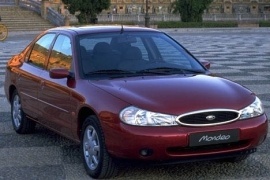
Just two years after introducing the Mondeo lineup, Ford refreshed the entire range and fixed most of the problems encountered with the 1994 model-year.
Ford switched from its European mid-size sedan from the RWD platform to the FWD platform with the Mondeo. It was a completely new car, designed from scratch. That led to some mistakes in the design and engineering process, which were revealed after the car’s launch. Soon, the blue-oval brand came with a facelift that changed 1400 parts of the car.
Apart from the door panels and the roof, everything else was changed on the bodywork. Even if the windows looked the same, they were not quite exactly the same. At the front, the bigger headlights solved the problem with the lighting since the non-facelifted version just barely lit the road ahead. Due to that, the hood had to be changed, and the grille featured the oval-shaped style. For the hatchback version, a sloped tailgate with a wide rear window made the car looks like a fastback, and the corner-mounted taillights followed the body shape.
The interior was tightened-up to cancel the rattles and squeaks that accompanied every road with a non-facelifted Mondeo. The designers installed a pair of cup-holders at the bottom of the center stack by removing the ashtray. For the hatchback, the rear bench featured a split-folding seatback to increase the luggage area.
Under the hood, the car featured a choice of engine, both diesel, and gasoline. A 1.6-liter powered the entry-level while the full version was a 2.5-liter V6. The standard transmission for the entire range was a 5-speed manual, and a 4-speed automatic was available for selected engines.
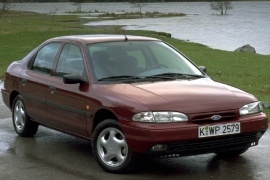
Ford invested one billion dollars in the Mondeo project, but the result was a global car available in three shapes: sedan, hatchback, and station wagon.
The mid-size vehicle segment was changing, and Ford understood that it had to develop new ideas. First of all, it developed a completely new platform and switched from the rear-wheel-drive Sierra to the front-wheel-drive Mondeo.
With its curved lines and slim headlights, the Mondeo was a revolutionary thinking vehicle for the blue-oval brand. That allowed them to minimize the grille, sharpen the front end of the car, and lower the aerodynamic drag coefficient. Unlike the Sierra, the new mid-size vehicle came with rounded body panels and smoother corners. For the hatchback version, a sloped tailgate with a wide rear window made the car looks like a fastback, and the corner-mounted taillights followed the body shape.
Inside, the designers continued the exterior’s rounded shapes with smooth and curved lines on the dashboard. The driver-oriented center stack was built as a natural extension of the instrument cluster. Between the front seats, the designers installed an armrest with a storage compartment. For the hatchback, the rear bench featured a split-folding seatback to increase the luggage area. Ford offered the Mondeo with a cloth or leather upholstery, depending on the trim-level.
Under the hood, the car featured a wide choice of engine, both diesel, and gasoline. A 1.6-liter powered the entry-level while the top version was a 2.5-liter V6. The standard transmission for the entire range was a 5-speed manual, and a 4-speed automatic was available for selected engines.























































